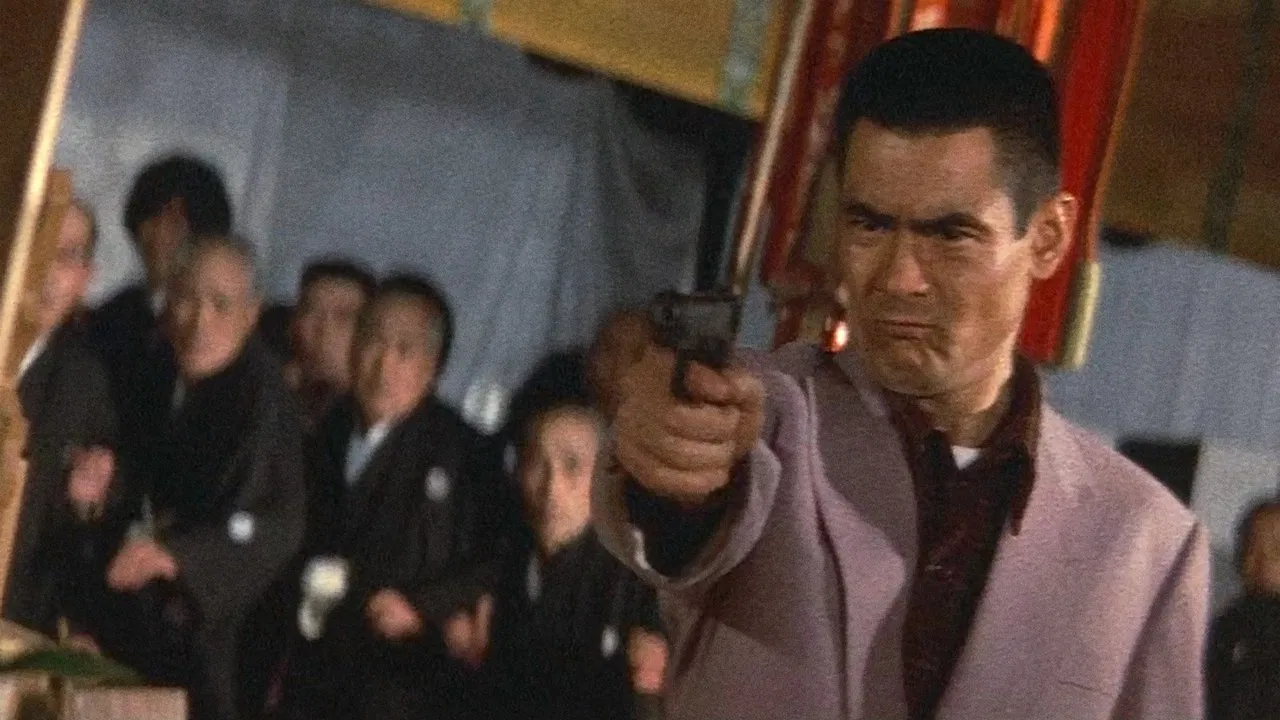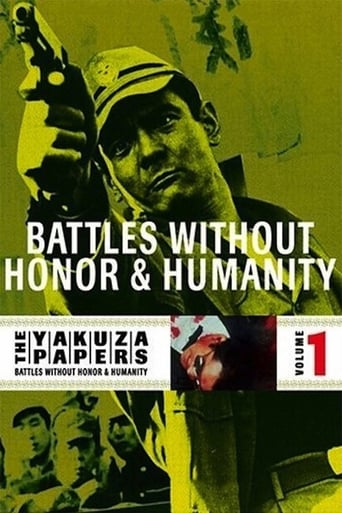

The "Japanese Godfather" Part 1This movie is told through three parts: First is the gang's come-up in the Yamamori clan and backstabbing their former boss Doi to please an Elder who's in competition, the second is Yamamori's drug business scandal which makes the gang war with each other, and the third is Tetsu going to war with Yamamori----------------------------------------------------------------------- It begins with Shozo getting introduced into the Yamamori clan after he becomes blood brothers with Wakasugi (Doi captain) watching over him as he commits harakiri to get out on early bail. The Yamamori clan bails out Shozo and they become a family under Okubo and Doi testimony. After the gang gets into a altercation with Ueda, Okubo nephew, Okubo orders Yamamori to fix a ballot of an upcoming election involving 50 billion yen. The gang completes the mission and upset Boss Doi at the same time who received the back-end of the fix. Doi, upset Yamamori fixed the ballot, sets out to kill him but Wakasugi gets in his way. Upset in his captain's betrayal, he punks Kunihiro to join his clan and betray Yamamori. Shozo is put on the hit on Doi life, and after he completes the mission Yamamori sends Kunihiro to hit Shozo. Wakasugi, suspicious of Yamamori, kills Kunihiro but is killed by police as he hides out.The Korean War has begun and Yamamori is on to new business. He enlists Arita and Shinkai to run his drug business under Tetsu nose, while enlisting Tetsu to periodically break up the racket so Yamamori can ship the drugs to Hiroshima. Tetsu and Ueda upset with the bosses secrets, tell him they will now run business legislations and expel Arita and Shinkai from the clan. Yamamori decides to stage a kill on Ueda which then ignites an all out war between Tetsu, Shinkai clan, and former Doi members. Tetsu decides to break free and start his own clan and Yamamori bails Shozo out of jail once again to commit a murder.Yamamori stages Yano's death to get Shozo to join his side against Tetsu. Shozo sees through Yamamori's lies and connects the dots he's involved with his blood brother Wakasugi's death. He decides to play neutral, helping neither Tetsu or Yamamori, but Yamamori prepared for this, sends hitmen out to kill Tetsu. Yamamori stages an elaborate funeral to honor Tetsu and all the fallen men over the past decade to please the elder Okubo. Shozo decides to crash and shoot up the place, and as he makes his exit he vows to avenge Tetsu.
... View MoreThere are few films as well-named as Fukasaku Kinji's "Battles Without Honor and Humanity" ("Jingi naki tatakai.') With one shot, Fukasaku (director of "Battle Royale") undid and entire genre of film, one that would never be the same again. A lone Yakuza, wielding a Samurai sword stands against a crowd, a brave sneer on his face. He is instantly shot and killed, his katana useless against a gun.Yakuza films in Japan were generally in a category known as Ninkyo Eiga, Chivalry Films. The Japanese mafia was shown as later-day Samurai heroes, defending and upholding traditional Japanese values of honor and loyalty above all else. This colorful imagery was supported by the Yakuza themselves, who loved seeing themselves portrayed in this heroic light.Fukasaku, with deep anti-violence sentiments, directed "Battles Without Honor and Humanity" in an attempt to set the record straight, to re-write the post-War history of Japan and unveil the true nature of these violent thugs, more interested in money than honor. The story unfolds over several years, following the career of Hirono Shozo, a former soldier and brawler who's own sense of loyalty to his Yakuza boss proves his undoing. Hirono is used as a pawn by several rival bosses and would-be bosses, seeking control over the Black Markets that sprang up following WWII.Hirano's narrative is only a framework for the deconstruction of a genre. Hard and true Yakuza genre tropes are constantly destroyed. Yakuza bosses break down and cry in front of their men, using money as a lure to get their way. Guns jam and run out of bullets, "brave" Yakuza hide under children attempting to escape the police...there is little sacred here.The disjointed storyline might be a little disorientating to those who have never seen a Yakuza film before, but Fukasaku helps you out with a running total of who has died. (A device that would reappear in "Battle Royale." ) A general background of post-WWII Japan would be helpful, but isn't necessary."Battles Without Honor and Humanity" is a landmark Japanese film. Harsh, violent and sending a powerful message, it is an amazing piece of work.
... View MoreDirector: Fukasaku Kinji Duration: 99 MinutesOpening with an image of the atomic bomb reducing Hiroshima to ashes, Fukasaku Kinji's Battles without Honor and Humanity begins a series of five movies depicting the chaotic life of Hirono Shozo a former soldier who is trying to survive in the chaotic world of the black markets in postwar Japan. A pretty even-tempered man, the viewer first witnesses Hirono lash out in violence when a group of American GIs try to rape a woman. Amidst the chaos of the black market with its prostitutes, underground rice kitchens, and violent bars, one of Hirono's friend's head is slashed by a yakuza. A rival yakuza was going to deal with the man, but in his stead Hoshino seeks revenge for his friend. Faced with a drunken, sword wielding yakuza Hirono empties his pistol into the man, and receives a twelve year sentence. However, while in prison, he meets another yakuza named Wakasugi who plans to slice open his stomach in order to get out of jail on bail. Promising to raise Hirono's bail money if he helps him in his plot, Wakasugi introduces Hirono into the world of the yakuza and the two men become blood brothers.A short time afterward, Hirono is released from prison and meets the head of the Doi family, the clan of the yakuza he went to jail for, and Yamamori the man who will soon be his gang boss. After Yamamori establishes his own gang, Hirono and several other toughs pledge their allegiance to him. However, almost from the beginning there is internal fighting in the ranks. How can a man as straight laced an honorable as Hirono work for a man like Yamamori who continuously plays his men against each other? During the late 1950s and the early 1960s a style of film called ninkyou eiga, or chivalry films became popular in Japan. For the most part these films portrayed yakuza as chivalrous beings who protected and preserved time honored traditions in Japan and expelled Western influences. Quite often in these films Westerners, Japanese heavily influenced by the West, and individuals of mixed blood were portrayed as villains while the sword wielding yakuza represented the purity of the Japanese spirit. It is not surprising that real yakuza were highly attracted to these films. However, Fukasaku Kinji viewed this portrayal of the yakuza as false and the ninkyou eiga films' portrayal of the yakuza, i.e. Japanese spirit, as being quite close to the wartime mentality. When Hirono draws his pistol and kills the sword-wielding yakuza it is a statement that the world of the yakuza is built on chaos and corruption not pure spirit. A highly recommended film and series for those who enjoy yakuza films and an important series for those who are interested in the evolution of the yakuza film.
... View MoreFor those who love yakuza films, this is one NOT to miss. Wild violence to start the film (two arms are lopped off within the first five minutes of the flick) sets a tone of dread (you don't know who'll be killed next). But more than action, the film brings a thoughtfulness to the fore. For those who want an English-language analogy, this film "feels" like Soderbergh's The Limey (though with a different plot and without the bouncing back-and-forth in time [though this movie does jump years in its narrative]).Don't miss this one...
... View More